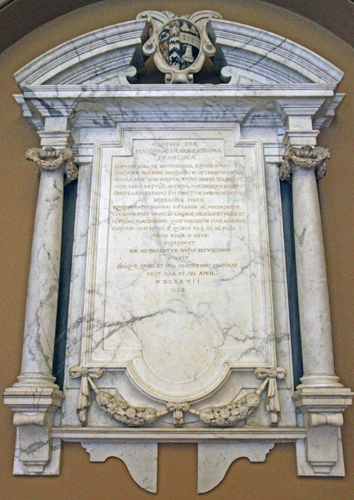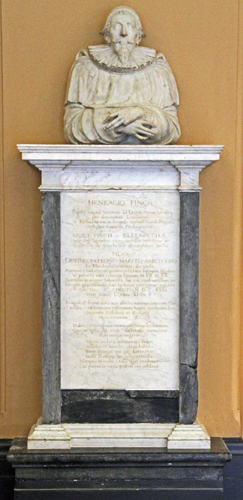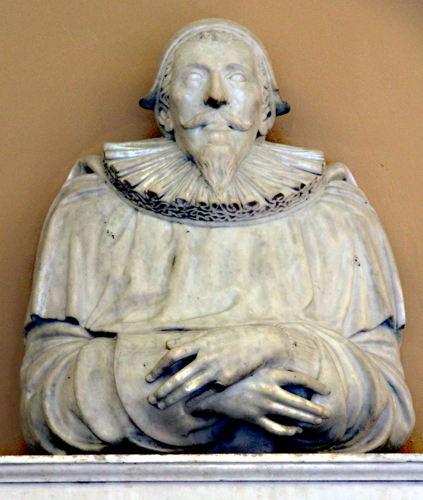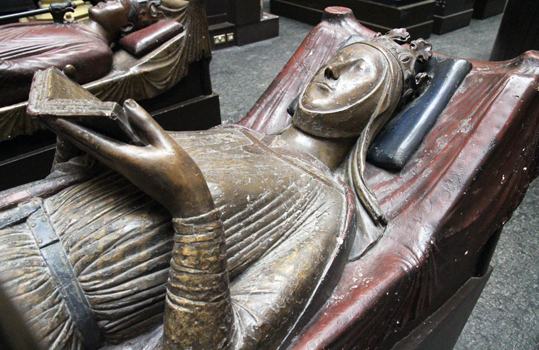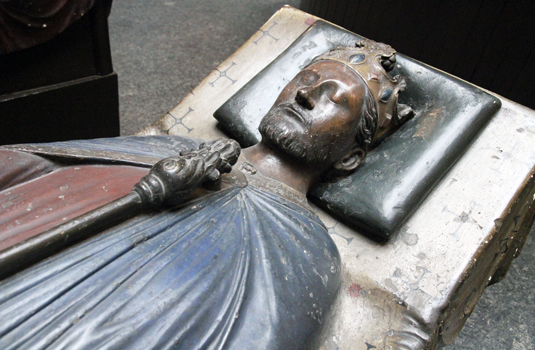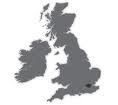 |
 |
GREATER LONDON |
 |
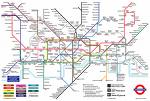 |
| <City of London I > <City of London II> <City of London III> <City of Westminster-1> <City of Westminster-2> <City of Westminster-3> <City of Westminster-4> <Borough of Wandsworth> |
 |
BOROUGH OF KENSINGTON & CHELSEA |
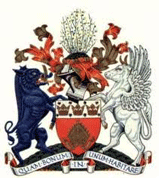 |
| Victoria & Albert Museum |
|
V & A Museum, Cromwell Road, Knightsbridge, London SW 2RL Entry is free but certain exhibitions may be charged for. Opening hours: Daily, 10.00 am until 5.45 pm except Friday, 10.00 am until 10.00 pm. But check the web site. |
| As well as a series of original effiges, obtained from several churches, in the Museum, there are many monumental effigies which are either plaster casts or electrotypes of the originals. These latter date from the mid to late nineteenth century and were made by leading cast makers of the day; they were bought by the museum to enable visitors to see these effigies without the then difficulty or high cost of travelling to see them. To some extend this still applies today and we must also now add the new additional problem of the ease or even possibility of access to the building housing them. Although it was never intended to do so these casts now allow visitors to see some of the effigies which are in Westminster Abbey without the high cost and restrictions of doing so. |
| Casting the Tombs |
|
Plaster Casts The initial impression of the original was often taken in plaster. The original was coated with a thin layer of a separating material to prevent the plaster sticking to the original. Because plaster is rigid when set and because most effigies - other than those in very low relief - have projections and undercut areas, these impressions were taken in sections; otherwise it would be impossible to remove the impresson without it fracturing and probably causing damage to the original work. The sections are called piece-moulds and are held together by a mother-mould, so that the sections can be reassembeled.These sections were then reassembled in an outer case and again painted with a separating material or mould seal, and the liquid plaster poured in. The plaster impressions were then removed leaving an accurate reproduction - other than the fine lines where the sections join- of the original effigy. The plaster impressions could be reused to produced a further cast. Impressions were also taken a mixture of wax and gutta-percha or gelatin, which are slightly flexible, as well as clay. As someone who has used this technique on a small scale, I can only but greatly admire the amazing skill of these cast makers. New rubber base materials which are highly flexible as well as very accurate would certainly make this process much easier today as well.
|
|
Electrotypes
This process produces a metal copy of the original. Again an impression of the
original is taken but now the impression is coated on the
inside with a graphite to give a thin, electrically
conductive layer. To add a layer of metallic copper to the
inside of the impression, it is inserted into an aqueous
electrolyte solution of copper sulphate and sulphuric acid,
and then connected to a direct electric current source as
the cathode, the anode being metallic
copper. When the current is activated, the copper anode
begins to desolve in the electrolyte and
deposited on the inside of the impression. When this copper
reaches the required depth the current is turned off, the
impression removed from the elctrolyte and, when the
impression is removed from the copper 'lining' a copper copy
of the original is produced.
This process is rather similar to that used during the production of vinyl and shellac sound recordings |
| For a history of the V&A's cast collection - of all types of sculpture - click here. |
| England |
| Westminster Abbey, City of
Westminster, London A Collegiate Church and a Peculiar. The most expensive church to visit in the world. |
 King Henry III |
|
||||||
 Queen Eleanor of Castile (Wife of King Edward I) |
|||||||
| The Temple Church, London A 'Peculiar' church. It belongs to two of the four Inns of Court: it is thus the Barristers' own chapel. It is thus not a parish church and the minister is titled 'Master of the Temple' Do not let this deter you: it is open to visitors. |
 William Marshall (1219) (RCHM no 10) |
 William Marshall II (1231) (RCHM no 8) |
 Unknown (RCHM no 7) |
 William de Ros (1316) (RCHM no 12) |
 Gilbert Marshal (1241) (RCHM no 9) |
Notes |
| 1. These effigies were always in the Temple
Church, with the exception of that of William de Ros, which was
brought from Yorkshire. 2. The plaster casts were made by Richardson after he had restored the effigies. His restoration was met with criticism. 3. They were damaged by enemy bombing during World War II, some severely, others less so. 4. So we can see what the effigies looked like before bomb damage but after Richardson had restored them. 5. There are nine effigies in all, plus a coped grave cover. Richardson made copes of five of these, ironically those that were to become the most severely damaged ones he did not copy. 6. Further information will be on the page about the Temple Church, not yet on line |
| Formerly in Lesnes Abbey, Kent (The London Bourough
of Bexley) Lesnes Abbey is a ruined abbey and open to the public. |
 |
 |
An unknown knight of the Lucy family (1340-50) |
|
| This effigy was discovered during excavations at the abbey and is now housed in the V&A. It is thought to represent a member of the Lucy family. The effigy is of Totterhome limestone with gesso, painted and gilded: this can be seen in the photograph on the left which was mainly in daylight. Medieval and Renaissance Room | |
| Worcester Cathedral A Cathedral Church. Open to visitors |
 King John |
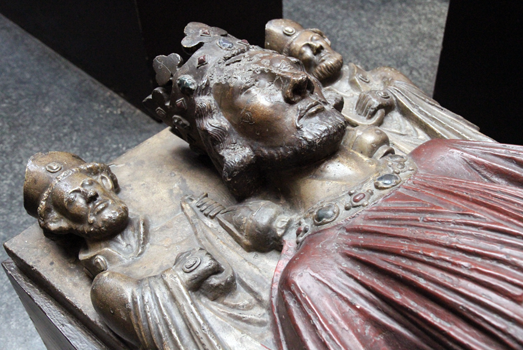 |
|
|
| Church of St John the Baptist, Lewes, Sussex A parish church |
Salisbury Cathedral, Salisbury, Wiltshire | |
 Gundrada de Warenne (1085) |
 Roger le Poer, Bishop of Salisbury (1102-1139) |
|
| 1. Gundrada is said to
have been a daughter of William the Conqueror. 2. She and her husband, William de Warenne, 1st Earl of Surrey, founded Lewes Priory but their remains and monuments were lost over the years. 3. Gundrada's tomb slab was found in Isfield Church covering a 16th century burial. It is of Tournai marble and dates from the later 12th century 4. Two lead chests containing the remains of Gundrada and William were found when the priory was excavated. The remains were sealed into new chests but the original ones are, together with the tomb slab, to be seen in the church indicated above 5. Plaster Cast. Room 46A |
1. This is a 12th century coffin lid of Tournai marble integral with the flat effigy of a bishop. 2. The head is in higher relief but this is a 14th century replcement and of Purbeck marble. 3. The slab came from Old Sarum, near Salisbury, where Roger was buried and late brought to the new cathedral at Salisbury to where the see was transferred. 4. Roger was a very wordly bishop and held the important secular posts of Lord Chancellor and Chief Justicicar 5. Plaster Cast. Room 46A |
|
| York Minster A cathedral church open to visitors |
 |
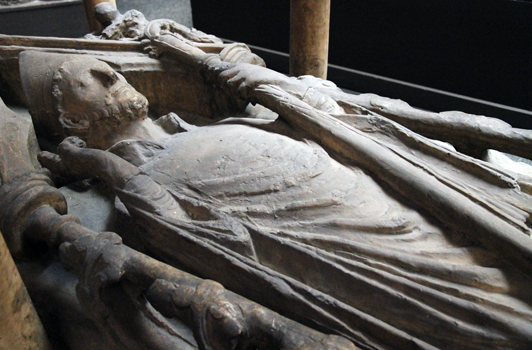 Archbishop Walter de Grey (1255) |
|
| 1. The monument is of Purbeck marble. 2. He is robed as a bishop rather than an archbishop 3. Under the effigy is a coffin with a painted effigy on the lid. 4. He was Lord Chancellor under King John 5. He was appointed Archbishop of York under the influence of King John and the Pope but the canons of York rejected his, feeling he was too poorly educated, and elected the brother of the Archbishop of Canterbury (an enemy of the King) instead. Walter eventually paid over £10,000 in papal fees to have his appontment confirmed. 6. Plaster Cast. Room 46A |
| Church of St Mary and St
Barlock, Norbury, Derbyshire A Parish church |
||
 |
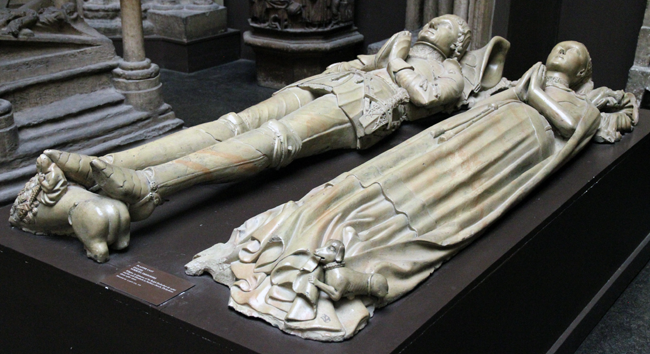 |
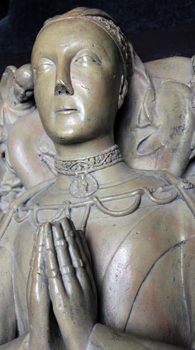 |
 |
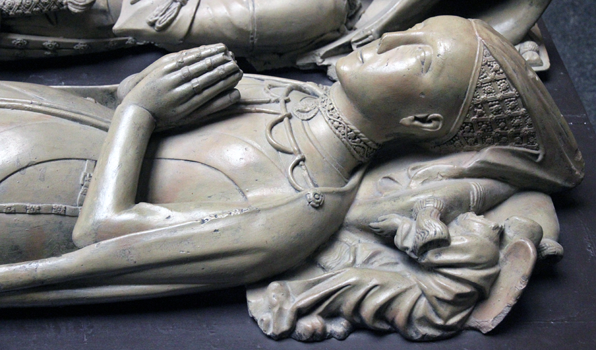 |
Sir Ralph Fitzherbert (1483) and his wife Elizabeth |
|
| 1. The original monument is
of alabaster. There are other monuments of interest in the
church 2. Plaster Cast. Room 46A |
|
| Chichester Cathedral,
Sussex A Cathedral Church, open to visitors |
|
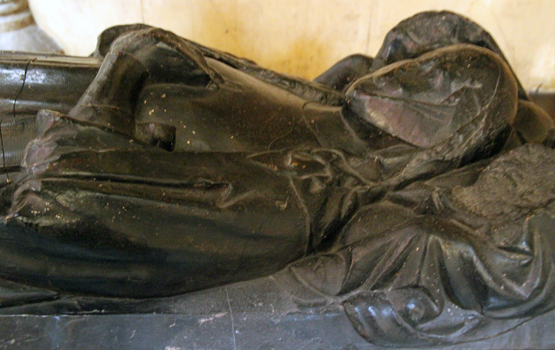 Joan de Vere c. 1300 (uncertain) |
 |
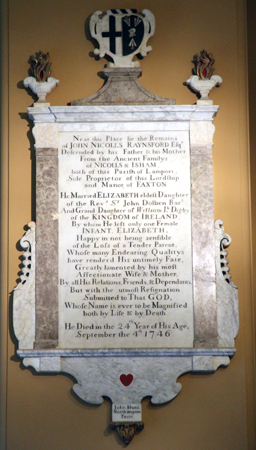 |
 |
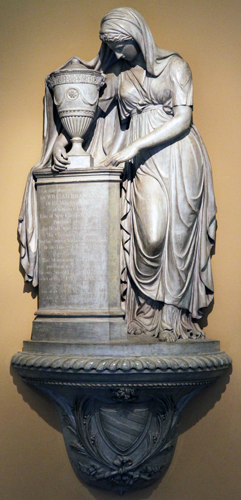 |
|
| John Nicholls Raynsford (1746) White marble and gilded and painted wood From Lamport with Faxton church Signed: John Hunt Northampton fecit Sculpture Room 24 |
Sir William Hillman Kn (1793) 'Of His Majesty's Board of Green Cloth' |
||
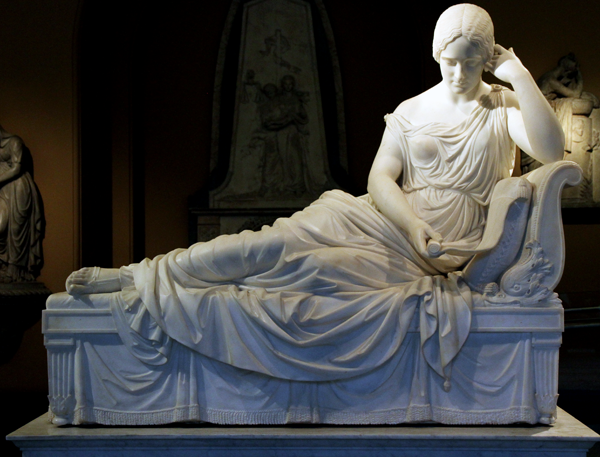 |
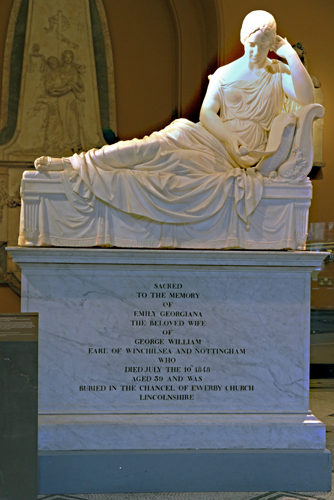 |
 Sir John Tyrell Bart (1766 at 40) Dame Mary (1766 at 31) |
|
| Emily Georgiana (1849) Wife of George William, Earl of Winchelsea and Nottingham Buried at Ewerby Church, Lincolnshire |
|
|
|||||||||||||
| France |
| Abbaye Royale, Fontevraud l'Abbey,
Maine-et-Loire This is no longer a working abbey of the Order of Fontevraud (or a prison) and is open to the public. It acts as a cultural centre. |
 King Henry II |
|
||||
 Queen Eleanor of Aquitaine (Wife of Henry) |
|||||
 King Richard I (Richard the Lion Heart) |
|||||
 Queen Isabelle of Angoulȇme (Wife of King John) |
| L'Épau Abbey, Yré-l'Évȇque,
Le Mans, Sarthe Very much like Fontevraud Abbey but smaller: l'Épau is no longer a working Cistercian Abbey and is open to the puplic. It also acts as a cultural centre. |
 Queen Berengaria of Navarre (Wife of Richard I) |
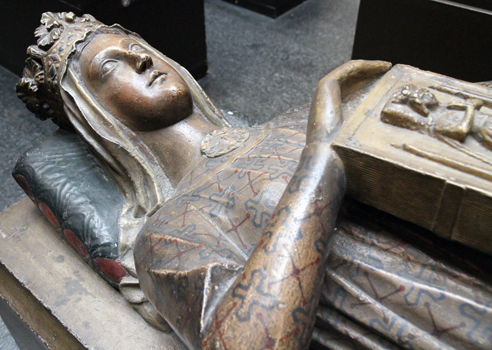 |
|
|
| Rouen Cathedral, Rouen, Seine-Maritime,
Normandy This is an active cathedral and open to the public |
 King Richard I |
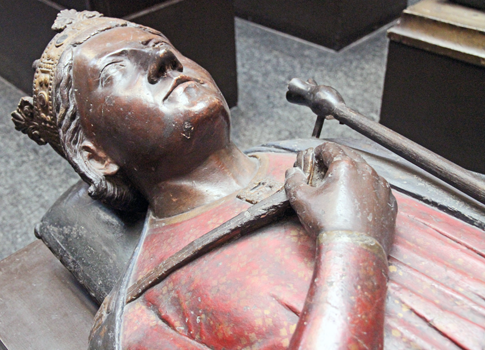 |
|
|
| Spain |
| Originally in the Church of St Pedro Ocaña, near Toledo |
 |
 |
 |
 |
| Don Garcia de Osono (1502) and his wife, Doña Maria de Perea (1499) |
These effigies were removed from the church listed above, when it was declared unsafe in 1906. They are of alabaster and constructed 1799-1505. |
| Germany |
| Römhild (near Rotermund), Hildburghausen, Thuringia, Germany |
 |
 |
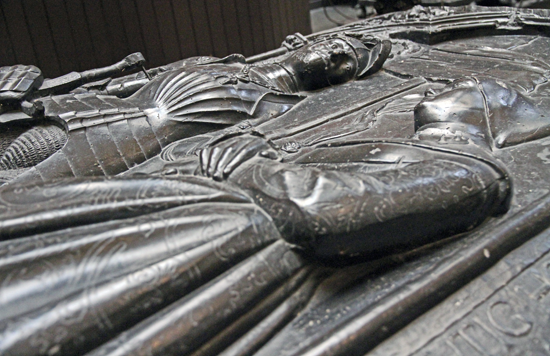 |
 |
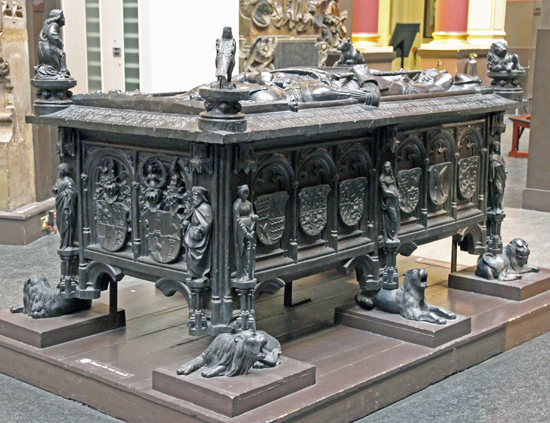 |
 |
| Elisabeth von Hehenzollen & Herman VIII Graf von Henneberg | |
| This is painted plaster cast made in 1873 by Jacob Rotermund. The original is cast bronze by Peter Vischer the Elder based on a drawing by Albrech Dürer. Room 46A |
| Church of St Sebaldus, Nuremberg, Bavaria, Germany |
 |
| St Sebaldus, the Patron Saint of Nuremberg |
| The original was
designed to hold a silver reliquary housing the remains of St
Sebaldus, and cast in bronze by
Peter Vischer the Elder in 150-19. The plaster cast was
made by Jacob Rotermunt in 1869. Room 46A |
| Magdeburg Cathedral, Magdeburg, Saxony-Anhalt, Germany |
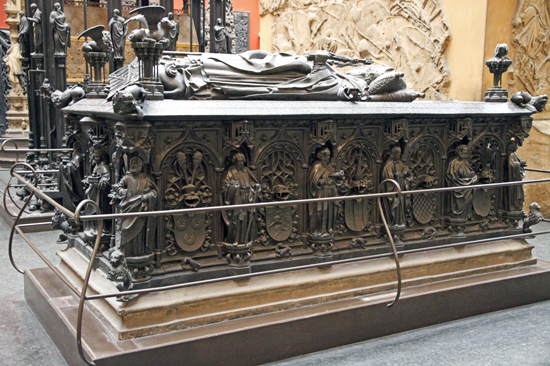 |
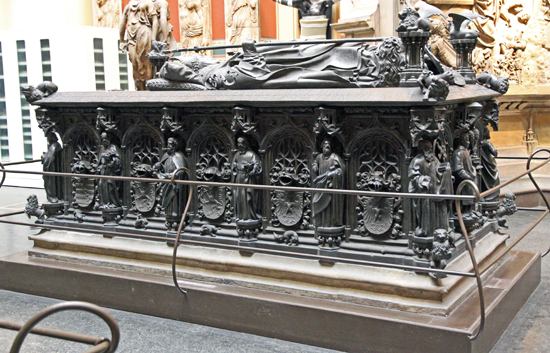 |
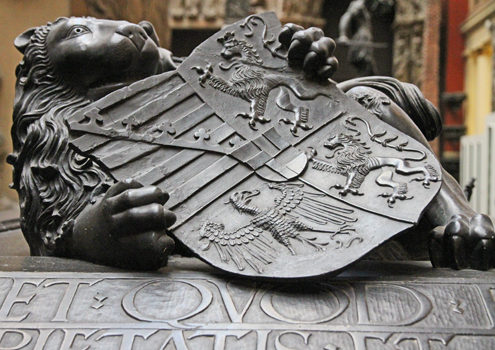 |
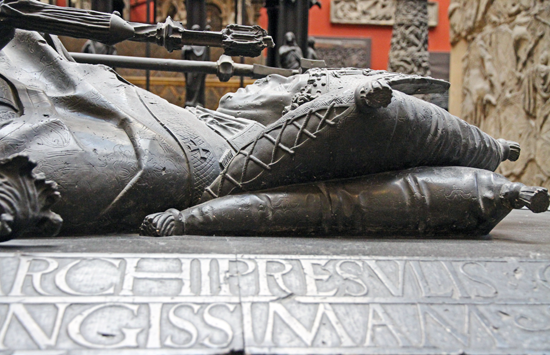 |
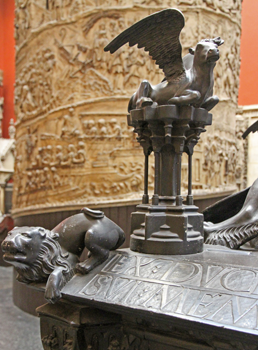 |
Ernst, Duke of Saxony and Archbishop of Magdeburg |
||
| The original was cast in bronze at Magdebury by Peter Vischer 1497. The plaster cast was made in Berlin in 1904. Room 46A | ||
| Italy |
| Church of San Francesco, Bologna |
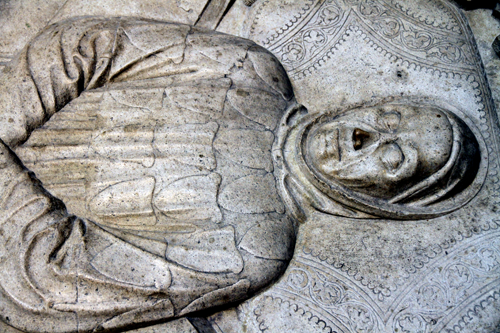 |
 |
| Tomb of a lector at
Bologna University. Identity not known. Made of Istrian stone
1425-1450. The condition suggests it was set in the wall rather than in the floor. Room 50a |
| Either from Church of Maddalena, St Cosma or St Giacomo, Venice |
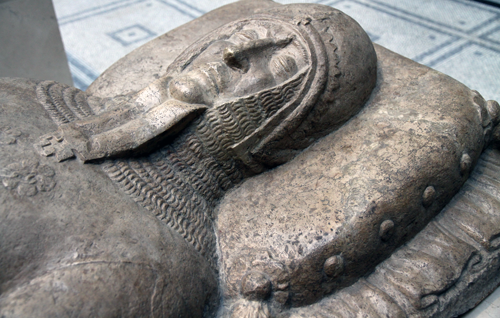 |
 |
|
| This effigy, of an unknown knight, was removed from one of the churches above, probably at the time of their suppression in the late eighteenth century and then found its way into an English private collection before being donated to the V & A. It represents an unknown knight and was carved 1370-75 in Istrian stone. Effigies of this type, period and place were wall mounted on a sarcophagus and tilted towards the observer so the could been seen. Room 50a |
| To Be Assigned | |||
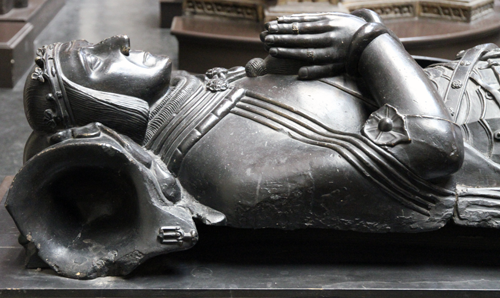 |
 |
||
 |
 |
||
 |
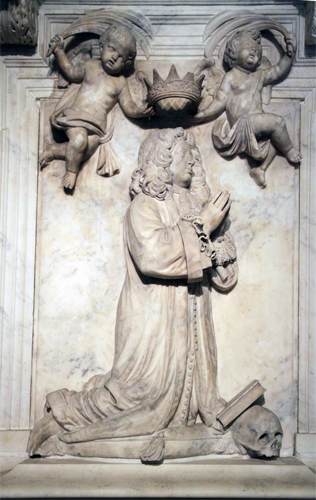 |
|
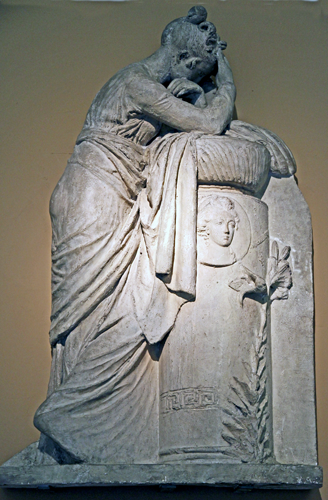 |
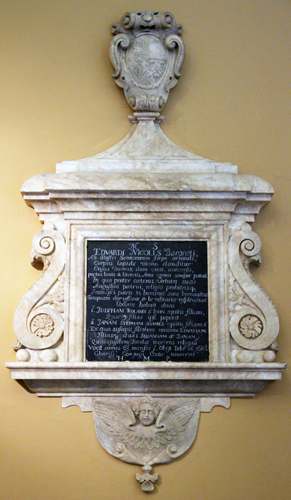 Edward Nicholls Bt 1682 |
|||
 |
 |
||
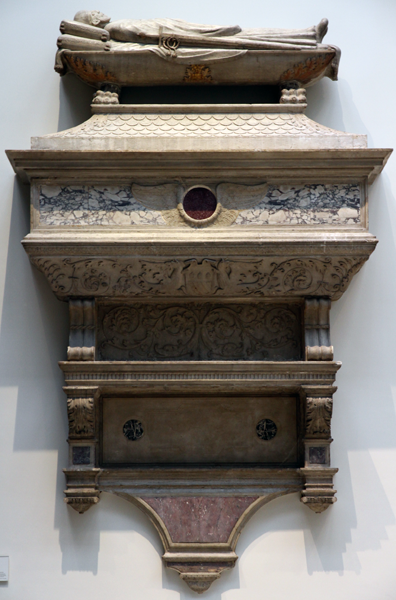 |
|||
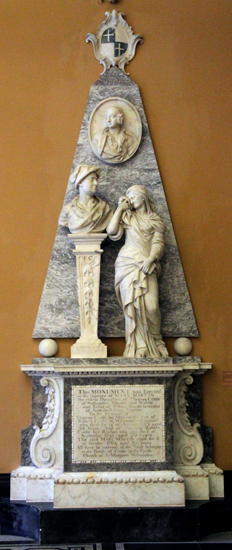 |
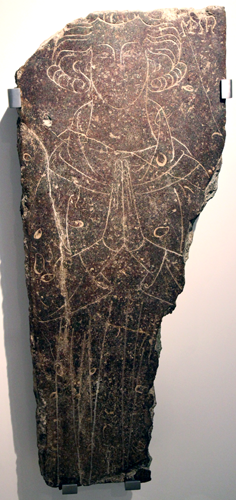
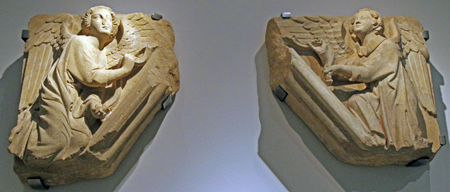 |
||
 |
 |
||
 |
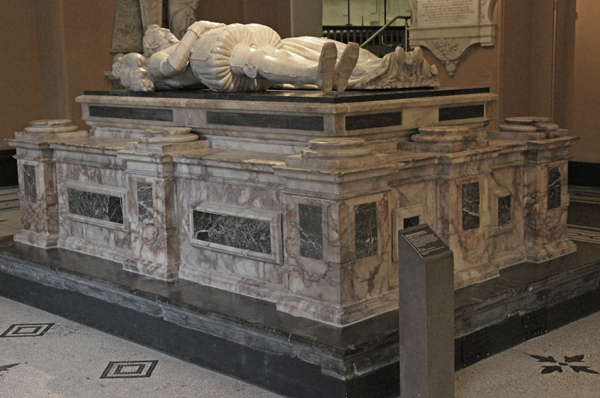 |
||
 |
 |
||
<City of London I > <City of London II> <City of London III> <City of Westminster-1> <City of Westminster-2> <City of Westminster-3> <City of Westminster-4> <Borough of Wandsworth>


